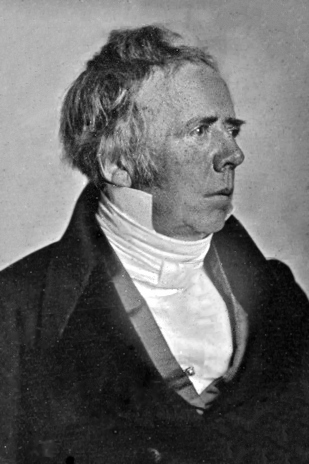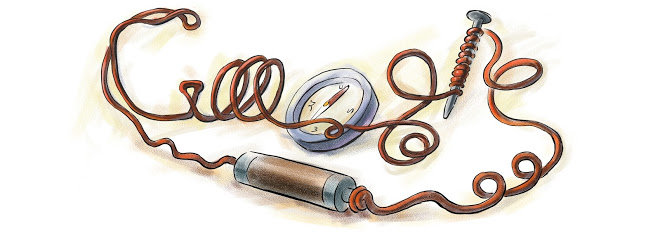Hans Christian Ørsted
Hans Christian Ørsted is a very important physicist and chemist who first discovered that electric currents induce magnetic fields. Because of his work, not only was a law and a unit of measurement named after him (Oe, CGS unit of magnetic field strength), but Ørsted is considered to be one of the leaders of the Danish Golden Age.
History
Personal Life
Ørsted was born in Rudkøbing, Denmark, to a pharmacist father who inspired his love for science. He enrolled in the University of Copenhagen in 1793 alongside his brother Anders - Hans studied medicine, physics and astronomy, while Anders studied law and later became Danish prime minister - and received a degree in pharmacy in 1797 and a PhD two years later. Hans' dissertation was titled "On the Form of an Elementary Metaphysics of External Nature" and was heavily influenced by Immanuel Kant. In particular, Ørsted firmly believed in Kant's idea that "a rational doctrine of nature deserves the name of natural science only when the natural laws at its foundation are cognized a priori, and are not mere laws of experience". It has even been theorized that Ørsted was initially rejected for a university chair position at Copenhagen because of his strong philosophical views; he later gained the position by demonstrating mass audience appeal for his lectures.
After graduation, Ørsted received a travel scholarship and spent it touring Europe, visiting notable philosophers such as Johann Gottlieb Fichte (founder of German idealism), Karl Wilhelm Friedrich Schlegel (Jena romantics), Friedrich Wilhelm Joseph Schelling (German idealism), and Johann Wilhelm Ritter, the latter of whom first influenced Ørsted's thinking that electricity and magnetism are related.
Intrigued, Ørsted returned to the University of Copenhagen and became a physics professor, researching electric currents and acoustics. And here is where the well-known tale begins.
The Discovery
Ørsted was teaching a lecture one evening in 1820 and noticed that turning an electric current on and off caused the needle of a compass sitting nearby to deflect. After extensive researching, he found that the magnetic needle aligns itself perpendicularly to a current in a wire, and that the magnetic field induced was overall circular in relation to the wire. This finding was later coupled with work done by André-Marie Ampère, who added the factor of time to create part of what is now Maxwell's equations; Ørsted's law in itself considers current to be constant over time.
Ørsted's Rules and Law

Ørsted's laws are as follows:
- The magnetic field lines encircle the current-carrying wire
- The magnetic field lines lie in a plane perpendicular to the wire
- If the direction of the current is reversed, the direction of the magnetic force reverses.
- The strength of the field is directly proportional to the magnitude of the current.
- The strength of the field at any point is inversely proportional to the distance of the point from the wire.
In its simplest form, "the line integral of the magnetic field [math]\displaystyle{ \mathbf{B}(\mathbf{x})\, }[/math] around any closed curve [math]\displaystyle{ C\, }[/math] is proportional to the total current [math]\displaystyle{ I\, }[/math] passing through any surface bounded by the curve.
- [math]\displaystyle{ \oint_C \mathbf{B} \cdot \mathrm{d}\boldsymbol{\ell} = \mu_0 I\, }[/math]
where [math]\displaystyle{ \mu_0\, }[/math] = 4π×10−7 V·s/(A·m) is the magnetic constant, and the direction of integration around [math]\displaystyle{ C\, }[/math] is related to the direction of current by the right hand rule."
When coupled with Faraday's Law of Induction, we get part of Maxwell's equations.
- [math]\displaystyle{ \oint_{\partial \Sigma} \mathbf{E} \cdot \mathrm{d}\boldsymbol{\ell} = - \frac{\mathrm{d}}{\mathrm{d}t} \iint_{\Sigma} \mathbf{B} \cdot \mathrm{d}\mathbf{S} }[/math] or [math]\displaystyle{ \nabla \times \mathbf{E} = -\frac{\partial \mathbf{B}} {\partial t} }[/math]
"The voltage accumulated around a closed circuit is proportional to the time rate of change of the magnetic flux it encloses."
Additional Contributions to Science and Otherwise
In a multidisciplinary feat, Ørsted also discovered piperine, a component of pepper, in 1820 and was the first to isolate metallic aluminum in 1825. He also wrote many published essays, both philosophical and otherwise, in addition to poetic works.
Ørsted further founded the Selskabet for Naturlærens Udbredelse (SNU - Society for the Dissemination of Natural Sciences), Den Polytekniske Læreanstalt ('Royal Polytechnique Institute') in 1829 (which later became the Technical Institute of Denmark - DTU), and organizations that eventually became the Danish Meteorological Institute and the Danish Patent and Trademark Office.
Select Accolades
1822: Given the prestigious Copley Medal by the Royal Society of London and an additional 3,000 gold francs by the French Academy
1822: Elected as foreign member of Royal Swedish Academy of Sciences
1936: The H. C. Ørsted Medal, established by SNU, was first awarded. A H. C. Ørsted Medal lectureship is also awarded annually to two prominent researchers.
1936: The Ørsted medal was established by the American Association of Physics Teachers as its most prestigious award, given for notable teaching in physics
1950-1970: Had 100 danske kroner note engraved with his image
1999: Had first Danish satellite named after him
1999: Had a Google Doodle made to celebrate his 232th birthday
Ørsted was also made a knight of the Prussian Order of Merit, of the French Legion of Honor, and the Danish Order of the Dannebrog. On his death in Copenhagen in 1851, he was given a state funeral.
Connectedness
- How is this topic connected to something that you are interested in?
Ørsted's discovery is indisputably foundational to the field of electromagnetism that so many other famous scientists have based their research on. The connection between electricity and magnetism has explained many phenomenon and expand into many industrial purposes. Furthermore, Ørsted in himself is extremely inspiring, branching out into not only physics and chemistry but also literature as well. I personally found it very intriguing that so much of his thinking is influenced by philosophy, notably Kant, and that he tied it together with physics to produce his dissertation.
- How is it connected to your major? Is there an interesting industrial application?
To quote National Geographic, "Ørsted's fingerprints are on everything from medical scanners to your car's engine to theoretical invisibility devices". For my major in particular, biomedical engineering, Ørsted's work comes into play with MRI's (Magnetic Resonance Imaging machines), which use a high magnetic field caused by electric currents induced in a wire. Any product in any industry that uses magnetic fields - hydroelectric dams and other electrical generators, for example - can attribute its success to Ørsted's discovery.

See also
An online interactive by MagLab at Florida State University where you can replicate Ørsted's original experiment: https://nationalmaglab.org/education/magnet-academy/watch-play/interactive/orsted-s-compass
NatGeo's feature on Ørsted: http://news.nationalgeographic.com/news/2009/08/090814-hans-christian-orsted-oersted-who.html
The Guardian's article on Ørsted: http://www.theguardian.com/news/datablog/2009/aug/14/hans-christian-orsted-science
Further reading
Der Geist in Der Natur by Hans Christian Ørsted
References
http://en.aros.dk/about-aros/press/2013/gold-treasures-from-the-danish-golden-age/ http://www.britannica.com/biography/Hans-Christian-Orsted http://people.seas.harvard.edu/~jones/cscie129/nu_lectures/lecture5/oersted/oersted.html http://www-personal.umich.edu/~jbourj/photogallery/photo00008310/oersted1.jpg https://en.wikipedia.org/wiki/Hans_Christian_%C3%98rsted https://en.wikipedia.org/wiki/Oersted%27s_law https://en.wikipedia.org/wiki/Oersted_Medal http://www.nndb.com/people/341/000104029/

